Iceland: How much things cost & how to visit on a low budget
Since its currency crash in 2008, Iceland had gone from absurdly expensive to somewhat reasonable in cost, and that has prompted thousands of new tourists to stream in to see what all the fuss is about. It’s hard to find a visitor to Iceland who didn’t absolutely love the place, but you won’t find anyone who tells you it’s cheap, so planning ahead is essential. Prices have continued to creep up in 2015 and 2016, so it’s again among the most expensive European destinations.
Many visitors arrive on an Iceland stopover going between North America and Europe, but with very cheap flights to and from Europe it’s becoming popular for adventurous types from all over the continent. In 2013 I spent 9 days in the country, always checking for prices and the cheapest ways of doing things, so below I can lay out how to budget and what to do to keep costs down.
Note: This article was first written in late 2013, but all prices have been updated as of December 2016 to be current through 2017.
Reykjavik vs. the rest of Iceland: Where to go
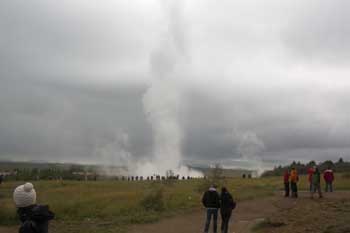
If you have one night or a few nights you are better off taking a bus or renting a car directly from the airport and heading east along the southern coast for some of the country’s best sights. If you have at least a week you’ll want to rent a car and do a lap around Iceland’s famous Ring Road, allowing you to see nearly everything the country has to offer in a neat and organized way.
Iceland accommodation: Hostels, guesthouses, and hotels
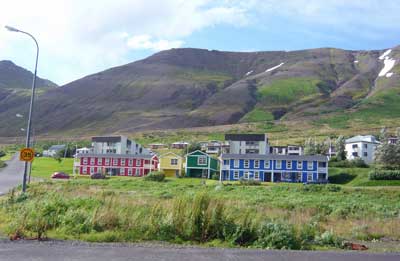
The most common form of accommodation in Iceland is a guesthouse and hostel combination which will have a mix of private rooms and dorm rooms, with shared bathrooms in down the hall. Most of them have fully equipped shared kitchens, so self-catering is at least as popular as eating out while exploring Iceland outside of Reykjavik.
High season (June through August) typical accommodation prices
All prices quoted in US dollars at a rate of about 110 Krona to US$1 in December, 2016.
- Hostel dorm bed: US$34 to US$58
- Single private with shared bathroom: US$85 to US$135
- Double private with shared bathroom: US$118 to US$140
- Double private with en-suite: US$130 to US$320 (and up)
Prices in Reykjavik are a bit higher than elsewhere in the country, but not by much. Prices in the off season are about 30% lower than in high season, but in the slowest months many places close so rates never go much lower than this.
Most Iceland guesthouses are NOT on the normal hotel-booking sites
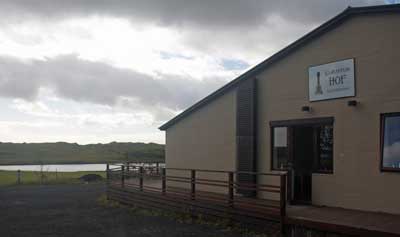
The good news is that when you get to Iceland, the tourism office will give you a directory of almost every guesthouse on the island, and there are other ways of finding these guesthouses and other informal accommodations. Even as of late 2016 you should be able to book a double room (with shared bathroom) for about US$120 per night in most towns in Iceland. If you do a hotel search you might see prices that are double that, but those are in the few formal hotels with 24-hour lobbies and such.
Increasingly, Airbnb and other online rental sites are the best place to find guesthouse accommodation in Iceland. As of only a few years ago, most places would be booked by phone or in person on arrival day, but now more and more places can be pre-booked, at reasonable prices.
Sleeping bag accommodation in Iceland
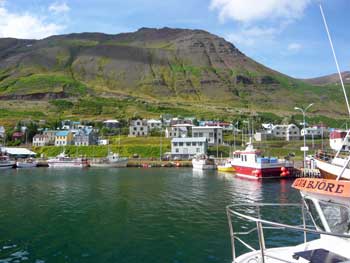
In a ‘sleeping bag accommodation’ (as it’s known in Iceland) you’ll get a bed with a mattress and often a pillow. So with even a cheap indoor sleeping bag, you’ll be comfortable and warm while saving quite a bit of money. For those renting cars, this is a highly recommended strategy.
You can rent sleeping bags in Reykjavik starting at around €12 per week.
Most Iceland attractions are free (the good news)
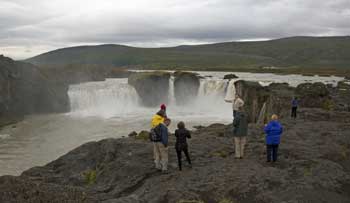
So to see all the glaciers and waterfalls and volcanic beds and other scenic attractions, it’s all free of charge with no admission cost or even parking fees. The larger attractions also have visitor centers where you can get local advice for free as well.
Iceland transportation: Rental cars and buses
Even as a lifetime public transportation fan, I’m very glad I gave in and rented a car to tour Iceland, even as a solo traveler. For the most part the roads are in perfect condition and virtually empty even in high season, so driving couldn’t be easier. Also, the country has stunning vistas every time you turn a corner, so being able to stop in the middle of the road even if there is no room to pullover, is critical.
The buses are modern but also expensive and running on very limited schedules. If you only have enough time to cover the main sights along the southern coast you might buy one of the bus passports that allows you to hop on and hop off, though a rental car is still much better and easier.
Rental cars in Iceland: What you need to know
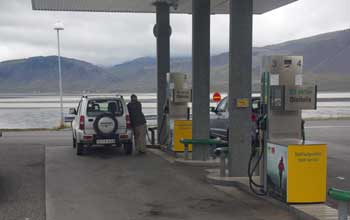
For an extra fee you can pay to reduce that deductible to almost nothing, but the more popular add-on is the Gravel and Glass insurance. For around €10 per day with this coverage you have a zero deductible if the vehicle gets damaged by gravel or if any glass gets broken by flying rocks (or anything else). Unfortunately, many of Iceland’s side roads and even a few of the main roads are covered in gravel, and if you drive at anything above a crawl, there will be some gravel flying around.
Personally, I normally decline add-ons like this but in this case I bought the Gravel coverage after reading a few horror stories in online reviews. I didn’t get any damage that I’m aware of, but the peace of mind was worth a LOT when driving on isolated gravel roads so I wasn’t petrified that I was chewing up the paint job just trying to stay safe on the roads.
Rental cars in Iceland
- 2-wheel drive compact (manual): US$230 per week and up plus add-ons
- 2-wheel drive compact (automatic): US$270 per week and up plus add-ons
- 2-wheel drive mid-size: US$450 per week and up plus add-ons
- 4-wheel drive van or SUV (automatic): US$650 per week and up plus add-ons
Daily rates are about 20% as much as weekly rates, so 5, 6, or 7 days cost the same.
Add-ons
Gravel coverage: US$10/day
GPS (highly recommended): US$10/day
Additional collision waiver: US$10/day
Fuel prices in Iceland
Every gas station in the country has the same prices, which don’t seem to change much. As of December 2016, a liter of petrol is 194 Krona, which is about US$1.75 or €1.63, or about US$7.50 per gallon.
Bus pass prices in Iceland
For a quick day trip from the airport to some local sights you can spend as little as US$90 per person, but for the longer distance buses you’ll spend at least US$130 to US$250 depending on length of time in order to hop on and hop off.
A Ring Road passport will cost around US$400 per person, so for two people it’s no cheaper than renting a car, even after fuel is taken into account, and for 3 or 4 people it’s definitely cheaper renting a car.
Food prices in Iceland
Here’s the thing: sit-down restaurants in Iceland are very expensive by international standards, so there aren’t very many of them. Obviously Reykjavik has many restaurant choices but most smaller towns might have only a few at most. The good news for budget travelers is that fast-food options are more plentiful, and self-catering is even cheaper and easier.
Restaurant prices in Iceland
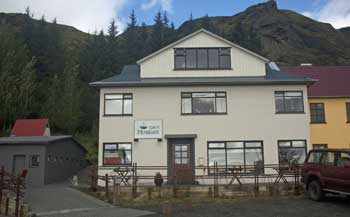
A soft drink, coffee, tea, or even bottled water will generally be between US$3 and US$5 in a restaurant. A pint of beer will typically start at around US$7 at even the cheapest places, while wine and spirits cost even more.
Fast food prices in Iceland
In Reykjavik and larger towns (which might only have 2,000 residents) you’ll have many fast food options including Subway, Quiznos, and usually a few local burger or hot dog places. Prices for a sandwich at Subway are about US$6 for a 6-inch and US$10 for a foot-long, so they aren’t too much higher than elsewhere in Europe, and are sure cheaper than proper restaurants.
More good news for drivers is that many gas stations around the country have fast food restaurants built in, so it’s fast and easy to pick up a sandwich or hot dog by the side of the road.
Hotel breakfast prices in Iceland
Many hotels and guesthouses in Iceland serve breakfast, but it’s almost always at an extra fee, and many don’t serve anything at all. If a breakfast is offered it will typically cost between US$12 and US$15 for a buffet of cereals, bread, cold cuts, cheeses, hard boiled eggs, juices, coffee and tea, and perhaps some pastries.
Making your own self-catering breakfast will be cheaper, but since you can stuff yourself for a flat fee at the breakfast buffets it might be worth it to save yourself the hassle of shopping the day before and making breakfast in the morning.
Self-catering in Iceland
The best budget tip for Iceland is to buy and prepare your own food, and you can literally do it for all three meals per day if you prefer. Since Iceland has almost no national “must-try” dishes, you can buy and prepare your own food without worry about missing anything meaningful.
Nearly every guesthouse in Iceland has a shared kitchen where at least half the guests will be storing and preparing breakfasts and even dinners. They have refrigerators, coffee makers, electric kettles, pots, pans, dishes, and silverware, as well as salt and other spices, so you can buy just the food and you’ll be able to prepare it all.
Supermarket prices in Iceland
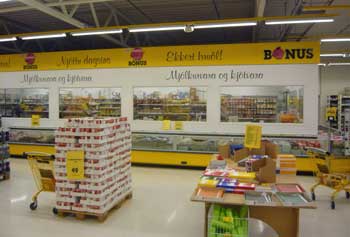
For example, you can buy a 400 gram (1 pound) block of Havarti cheese for around US$5, but a similar looking cheese right next to it on the shelf might be US$15 for the same amount. The same is true for lunch meats. Sliced ham can be US$3 for enough to make 2 sandwiches, but sliced roast beef might be US$10 for the same amount.
Some sample prices in the cheaper Iceland supermarkets
- Sliced white bread: US$1.70 per large loaf
- Fresh baguette: US$1.50 to US$2 each
- Hot dog buns: US$2.50 for 5
- Pork hot dogs: US$3.50 for 5 large hot dogs
- Cheap Havarti or other local cheese: US$5 for 400 grams (1 pound)
- Imported cheese: US$10 to 15 for 400 grams (1 pound)
- Sliced ham for sandwiches: US$5 for 400 grams (1 pound)
- Sliced roast beef for sandwiches: US$12 for 400 grams (1 pound)
- Pasta: US$1.50 for .5 kilogram (1.1 pounds)
- Pasta sauce: US$3 for a .5 liter jar
- Ground beef: US$5 for .25 kilos (half pound)
- Bake-at-home pizza: US$5 to US$7 for one person
- Bag of tortilla chips for 2 or 3 people: US$2
- Jar of salsa for those chips: US$3
- Breakfast cereal: US$3 to US$5 per box
The prices above are for many of the cheaper and more common things that budget tourists buy in Iceland. As mentioned above, if you want something exotic and imported, it might cost double or triple what you pay at home, if you can find it at all.
Alcohol prices in Iceland
In restaurants and bars throughout the country you’ll pay at least US$8 for a pint of beer, and at least US$10 for a glass of wine or a simple cocktail. If it’s a fancy place you’ll pay even more, of course.
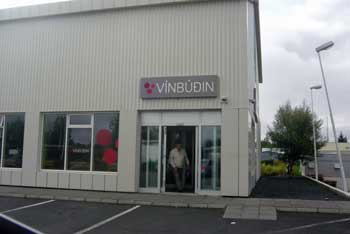
Here are some typical prices for alcohol:
- 330ml can of local beer: US$2 to US$3
- 500ml can of local beer: US$2.50 to US$4
- Cheapest bottle of wine: US$10 to US$12
- .7L bottle of off-brand vodka: US$30
- .7L bottle of mid-level brand vodka: US$50
Bottom line on doing Iceland as cheaply as possible
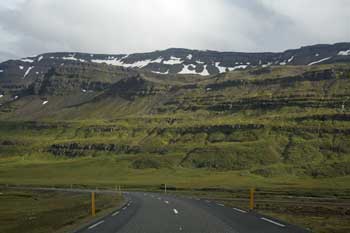
Whether you are going to get dorm beds or private rooms, as long as you will have your own wheels it’s worth renting a sleeping bag. You get the same bed and same services for about US$10 less per night, which will pay for a week’s rental of an indoor sleeping bag.
Unless you are a terrible driver or afraid to drive, it’s highly recommended to rent a car instead of trying to get around using buses. Once you get there you’ll see that having 100% flexibility with a car compared to almost no flexibility with a bus, is worth a LOT.
Instead of trying to be cheap with transportation, be cheap with self catering food and drinks for yourself. If you have at least a small group of people you’ll be able to have a party each evening in or near the shared kitchen of your guesthouse, and it will be more lively than any restaurant in town.

Great information. Thank you!
I know that camping space is widely available(outside of city limits and after checking with land owners) however, I have been trying to find out if there are more formal campgrounds that will be open (with running water) between mid September and mid October. While I know this a colder time of year I would like to understand if there are any options available.)
Also, thanks for the wonderful article! I have been on the fence about making a solo trip to Iceland and am 99% sure that I am headed there for 5 day trip this fall.
Thanks
Ruth
Ruth (or Chris)
I’m glad you enjoyed the article and I’m sure you’ll love Iceland. Camping isn’t something I know a lot about, although it’s obviously big in Iceland, especially during the summer. I was curious about this as well and discovered a good page dedicated to Iceland campgrounds open all year. They filtered the results from the master list put together by visiticeland.com. It looks like most campgrounds are only open in summer, but about 20 are open year round and they are spread over most of the island. Have a wonderful trip. -Roger
Is fruit there expensive? I practically live off fruit. Where ever I travel I bring a mini blender with me so I can make smoothies every day. And what about fresh green and other veggies, are those easy to find/buy ? And are they expensive compared to US super market prices? Thanks!
Bethany,
Oooh, interesting question. I’m not much of a fruit eater so I didn’t really notice, but I did notice that veggie prices were pretty reasonable. My guess is that apples and other fruit like that that doesn’t spoil quickly will be fairly cheap. Weirdly enough, fruit is often cheaper in Europe than in the US. Most things in Iceland are at least a bit more expensive than in mainland Europe, but I’d guess it’s maybe 20% or so. Sorry I don’t have a better answer, but long story short, I’d expect that fruit would be pretty affordable because the governments in Europe help make that possible. I don’t think you’d be paying, say, US$2 for one apple, if that is what you are worried about.
Actually, this site is pretty reliable for supermarket prices and things like that. It looks like fruit isn’t too expensive to afford. Have a great trip. -Roger
Hi Roger, thank you for all the useful information on here. We are going to Iceland for 2 weeks in August and will be staying on a farm in the middle of nowhere in the North for some hiking. We are planning on hiring a 4×4 after your helpful comments.
Jane,
I’m glad I was able to help. You definitely need a 4X4 to go into Iceland’s interior, and it sounds like you’ve got quite an adventure in mind. Bon voyage. -Roger
Dear Roger,
I am reading all conversations in the block and slowly building up my itinerary towards my 7-day trip in Iceland on late August. As I go through the small details now I need a piece of advice from you on the following issue. We are doing the ring road clockwise so the third day we will be staying at Akureyri. On the following morning I am thinking to go through Godafoss, Myvath, Namafjall, Krafla caldera and then Detifoss before ending in Elgisstadir to spend the night. Doing the math that will be a distance of approximately 300Km from Akureyri to Elgisstadir including these stops. I am wondering if I will make it by 7PM say to be on my next stop. I know this is a bit challenging question to discuss but I will appreciate any comments on your behalf. Maybe I should skip some stops? Thank you
Harris,
Interestingly enough, on my late-August Ring Road trip, I stayed in Akureyri the second night and Elgisstadir the third night. I don’t remember the specific stops I made that day, but I’m sure it was most or all of the same ones. I think I skipped one that required something like a 10km drive each way on a gravel road to reach because I was worried about the time and also you have to drive quite slow on those gravel roads. The Ring Road itself in that area is all paved, so you can move quickly.
It seems that tourism has increased by some degree since my trip a few years ago, but still I’m sure you’ll be amazed at how empty northern Iceland is, in a wonderful way. That third day on the road was a long one and I think it was dark by the time I got to the guesthouse where I stayed, but I’d do it again in a heartbeat. You’ll just have to get an early start and play it by ear, and I’m pretty sure you’ll be able to do all or almost all of it. I stayed in Hofn on my fourth night, and there are a few gravel patches of the Ring Road along the coast, so that one can be a bit slow. There aren’t many notable attractions in that stretch, so it’s another pretty easy drive as long as you start early. Have a great trip and let me know if you have other questions. -Roger
Hi Roger,
Thanks for the response. She would be renting a car. So you think 2 weeks is all you need to travel throughout Iceland and do all the hiking, etc. She is very outdoorsy.
Thanks for your help.
Diana
Diana,
That’s great that she is renting a car. She can do the whole Ring Road in one week, but if she has more time she’ll enjoy it more by taking her time. I’d say 10 days would be fantastic, and 14 days would be enough to see almost everything in the country, aside from the sights in the center of the island that require a 4X4 to reach. -Roger
Hi Roger,
My daughter is thinking of going to Iceland after she graduates this summer. She has plenty of time, but how much time do you thinkshe will need to tour, hike and take advantage of everything? Also, she would be travelling alone – do you think that would be a problem? Would it be better for her to plan on staying in campsites or in hostels? Thanks.
Diana,
Iceland can actually be a bit challenging for solo travelers without a rental car. There are some bus companies that connect the main tourist sights, especially along the southern coast, but their schedules are fixed so you have to be ready to catch the bus when it comes each day. On the other hand, it’s extremely safe, so I wouldn’t worry about that part. And Iceland is the most amazing place I’ve ever been, and I’ve been almost everywhere, so I do think it’s a great idea.
Assuming she doesn’t want to rent a car, I’d say the best plan would be to look into the bus passes, which allow you to do a certain route or loop in as short or long of a time as you want. There are hostels in pretty much all of the sightseeing areas where the bus stops, and those would be easier than camping. If you’ve looked at the weather in Iceland, you’ve noticed that days in summer are fairly cold, and nights are obviously colder. Unless you have all of the equipment for those temperatures, I’d think that just doing hostels will be much easier and also more social.
Have a look at those Iceland tour bus routes that allow you to hop on and hop off at various stops around the country. I’d say 4 days would be the minimum time to see the highlights, and in 2 weeks she could see almost everything. If she wants to do the Ring Road then 7 or 8 days is usually ideal, although it might be a bit complicated depending on when the bus leaves each day from each stop. Sorry I couldn’t be more specific. Let me know if you have any other questions. -Roger
HEllo Roger,
Your posts are really enriched with important informations. So I want to know that I am planning to visit Iceland in the month of June’17. So if i opt for renting a campervan, I think that will somehow curtail my accommodation cost. I have planned to wrap up my trip in 7-8 days. My questions are..
1. What will it cost for renting a campervan and is it a right idea to stay in a campervan ?
2. Can you suggest the places we must visit during our stay ?
Rana,
I rented a normal car when I was there and I didn’t actually see too many campervans. But I do know they have them there, and you’ll have better look checking the prices online. I’m sure they are quite expensive, but they still might be a good deal to save the cost of guesthouses. Since you have at least a week I’d highly recommend doing the full Ring Road. I’d assume that there are holiday parks along the way, but I’m not actually sure. There are definitely places to stay in a campervan along the southern coast, which also has the most interesting sights.
When I was there and did the Ring Road I used the Lonely Planet guidebook on my iPad. There are waterfalls and interesting sights all over the island, mostly along the Ring Road. I can’t give you a list of them, partly because the spellings of the names are all so unusual. Have a great trip and I’m sure you’ll love it. -Roger
Hi Roger,
I found this web site and its very informative. Planning to visit Iceland mid april with my wife and the two yr old.
I read trip advisor and also your blog and came up with the itenary below.
Day 1 – arive at Reykjavik early morning, rent a car and look around the city. Stay the night.
Day 2 – Do the gloden circle and stay the night in Selfoss area.
Day 3 – Drive to Skaftafell visiting attractions and stay the night.
Day 4 – Drive to Höfn visiting attractions and stay the night.
Day 5 – Drive back to Vik and stay the night.
Day 6 – Drive back to Reykjavik stay the night and take the early morning flight.
Still need to which attractions to see on route. By the way do you thing we should drive further up north? I really wanted to do the entire ring road but was not sure about the road conditions and time it will take. Apreciate any advice.
Many Thanks,
Raj
Raj,
You’d really need at least 6 days to do the full Ring Road, mostly because there are so many amazing things that you’ll want to stop often so you can only drive so many hours each day. If you tried to do it in 5 days you’d find yourself driving by things you’d like to see, just to stay on schedule. So I think your idea of focus on the southern coast is wise.
You might consider renting your car on Day 2. You could take a shuttle bus from the airport to Reykjavik and then do your sightseeing on foot or by bus. Honestly, Reykjavik is not a very interesting city and the main tourist area is only about 3 blocks by about 10 blocks. I actually did the hop-on, hop-off bus tour in order to see what else was around, and I wasn’t too impressed. It’s a pleasant enough city, but it is expensive and the natural attractions elsewhere in Iceland are really what you want to focus more on. You might even rent a car on Day 1 and drive east and just save that last afternoon and evening in Reykjavik.
Speaking of that, I did the Ring Road clockwise and I visited the Golden Circle attractions on my last full day. Interestingly, I actually found them to be a bit dull compared to the things I’d seen for the whole week before, and also FAR more crowded. The waterfall that is part of it is one of the better ones, but the Geysir field and continental divide are just okay. In other words, you might also want to save those for the end, and you might end up skipping one or more of them. The reason that the Golden Circle is a big deal is that those 3 things are easy to see on an 8-hour trip starting and finishing at the airport. But because of those airport tour buses, they are all way more crowded than anything else in Iceland.
As I’ve mentioned elsewhere, really the best and most interesting sights on the Ring Road are most concentrated on the southern coast. So I don’t think driving north is worth the time. They are beautiful roads north of Reykjavik, but there aren’t many actual sights until you get close to the north coast. So you might just rent a car on Day 1 from the airport and plan on reaching Höfn by the end of Day 2. That would allow you the rest of your trip to slowly make it back to the airport area, seeing everything you want with plenty of time to spend.
One last thing to mention is that the airport is about 50km from Reykjavik and there is virtually nothing between them except for lava fields. I do think spending one day and evening in Reykjavik is worthwhile if it interests you, but if you do that on your first day then you might be better off staying that last night close to the airport. You could visit the Blue Lagoon on your way, as it’s much closer to the airport than it is to Reykjavik. And it’s very interesting to see, even if you aren’t going to pay to swim. Let me know if you have any other questions. -Roger
Hello Roger,
I am planning a trip in late August this year to Iceland, and there was a lot of information on the basics. (I.E. Airfare, Jeep rental with tent topper to cut down on price and see Highlands, as well as Fuel.) But the overwhelming questions are about “food” from rough estimates of a single day “basic self catering”? To whether or not you can bring backpackers dried food from the States? Or should I wait and go to Kasco Netto or even Costco? “Which I guess is opening this summer’17.” Any kind of information would be greatly appreciated!
Thank you for your time.
Chris
Chris,
The news of Costco opening is new to me, and that is very cool. Still, I’m not sure whether it’ll be worth going out of your way to drive to that suburban location to stock up on large quantities of things. There are decent-size supermarkets in every town of any size, so there will be at least one in each town you sleep in, or at least on your way to that town. I do list the price of groceries in the article above.
I was actually surprised that so many things were reasonably priced there, and I’m sure that is still true. As I mention in the article, there are very few actual sit-down restaurants in Iceland and those that are there are very expensive. So it seems that most people staying at guesthouses shop for groceries and prepare food in the common kitchen at each place. That’s what I did on most nights, and the kitchens are quite busy, and a good place to be social as well. Specialty items and imported items CAN be double the price that you are used to, but things like dried pasta and bottled sauce are almost the same price you’d find in the US or Europe. And weirdly enough, every supermarket in Iceland has a little section of Mexican items such as tortillas and taco mix etc, and many Icelandic families enjoy Mexican food on a certain day each week.
I’m a pretty cheap guy and I was worried that even making my own dinners might cost US$10 each or something, but I was able to make pasta and meat sauce with bread for maybe US$5 for a large portion. In other words, it really doesn’t have to add up to too much, so it may not be worth going hours out of your way to try to save US$20 for a whole week. Have a great trip. -Roger